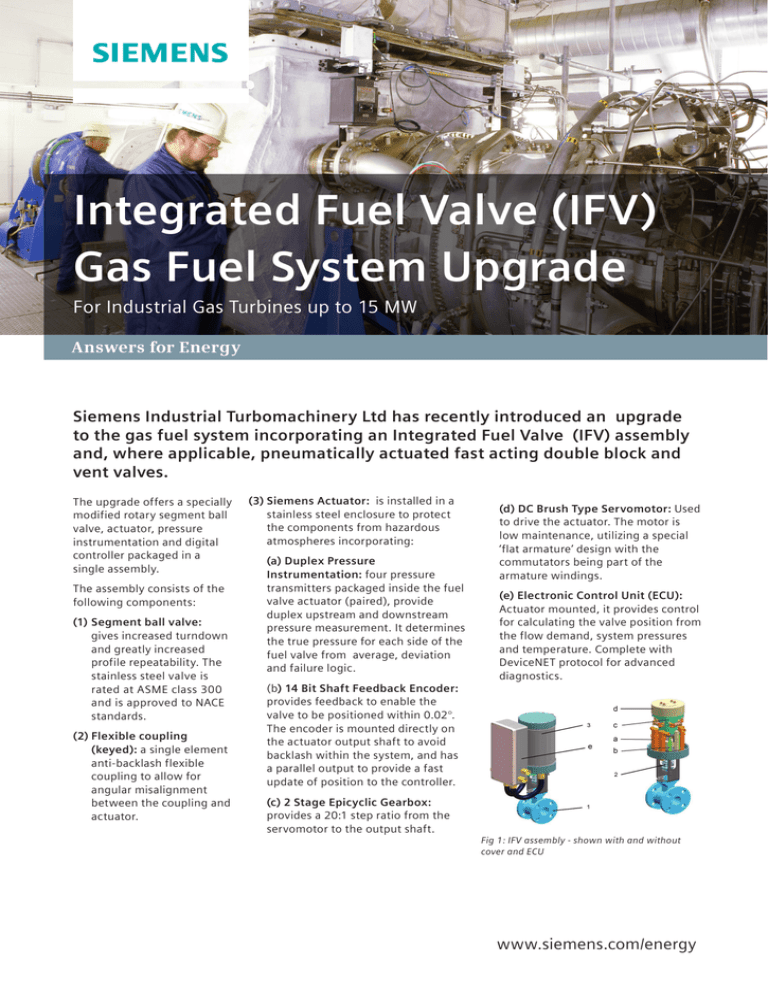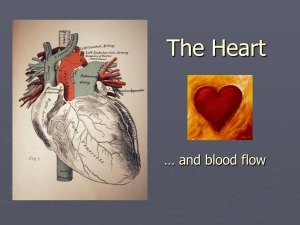
Integrated Fuel Valve (IFV)
Gas Fuel System Upgrade
For Industrial Gas Turbines up to 15 MW
Answers for Energy
Siemens Industrial Turbomachinery Ltd has recently introduced an upgrade
to the gas fuel system incorporating an Integrated Fuel Valve (IFV) assembly
and, where applicable, pneumatically actuated fast acting double block and
vent valves.
The upgrade offers a specially
modified rotary segment ball
valve, actuator, pressure
instrumentation and digital
controller packaged in a
single assembly.
(3)Siemens Actuator: is installed in a
stainless steel enclosure to protect
the components from hazardous
atmospheres incorporating:
The assembly consists of the
following components:
(1)Segment ball valve:
gives increased turndown
and greatly increased
profile repeatability. The
stainless steel valve is
rated at ASME class 300
and is approved to NACE
standards.
(2)Flexible coupling
(keyed): a single element
anti-backlash flexible
coupling to allow for
angular misalignment
between the coupling and
actuator.
(a) Duplex Pressure
Instrumentation: four pressure
transmitters packaged inside the fuel
valve actuator (paired), provide
duplex upstream and downstream
pressure measurement. It determines
the true pressure for each side of the
fuel valve from average, deviation
and failure logic.
(d) DC Brush Type Servomotor: Used
to drive the actuator. The motor is
low maintenance, utilizing a special
‘flat armature’ design with the
commutators being part of the
armature windings.
(e) Electronic Control Unit (ECU):
Actuator mounted, it provides control
for calculating the valve position from
the flow demand, system pressures
and temperature. Complete with
DeviceNET protocol for advanced
diagnostics.
(b) 14 Bit Shaft Feedback Encoder:
provides feedback to enable the
valve to be positioned within 0.02°.
The encoder is mounted directly on
the actuator output shaft to avoid
backlash within the system, and has
a parallel output to provide a fast
update of position to the controller.
(c) 2 Stage Epicyclic Gearbox:
provides a 20:1 step ratio from the
servomotor to the output shaft.
Fig 1: IFV assembly - shown with and without
cover and ECU
www.siemens.com/energy
Fast Acting Double Block & Vent Valves
Benefits
The IFV design: provides a gas
flow control package in a single
assembly which enables testing
to be completed at the point of
manufacture, minimizing site
installation set-up time.
Calibration details for all valves
are established at the factory
and can be reproduced when
requested.
In conjunction with the Integrated Fuel
Valve, the system includes a further
package of safety equipment: An on-skid fast-acting double block and
vent valve assembly to enable removal
of the existing pressure proving system
(if fitted).
The Fast Acting Block and Vent Valve
Assembly comprises four main
components; two fast acting, gas fuel
block valves, one gas fuel vent valve,
one isolation and calibration valve.
The two block valves are installed in
tandem into the main gas fuel feed line
separated by a short tee socketed spool
pipe. Branching off this spool pipe is the
vent valve, which will rapidly exhaust, to
atmosphere, the gas trapped between
the main block valves when they are
closed. Also tapping into the spool pipe
is the isolation and calibration valve.
This provides a convenient access point
for manual testing, integrity checking,
and diagnostic analysis.
In operation, the block valves work
together to either allow or prevent the
flow of gas fuel to the turbine with a
very quick response time, closing within
100 milliseconds.
The block and vent valves have an overtravel design, which ensures full seating
and virtually guarantees sealability.
However, if any gas fuel did leak beyond
the first valve, it would also be vented to
Improved reliability: the
simplified robust ball valve and
actuator combination of the IFV
improves both the accuracy and
operational reliability with greater
operational tolerance, even under
the most arduous conditions.
Fig 3. Block & Vent valve arrangement
atmosphere thereby preventing a
pressure build up occurring behind the
second valve. This ensures that gas fuel
isolation is complete.
Both the block valves and the vent valve
employ position monitoring, to monitor
the valve stem position and relay the
status information back to the Turbine
Control Module where it is compared to
the positions demanded by the control
system. If there is a discrepancy, an outof-position alarm, trip, or start inhibit will
be initiated - depending upon the current
operational status of the turbine.
Pressure Equipment Directive 97/23/EC
(UK Pressure Regulation SI1999 No
2001).
ASME Code for Pressure piping, Process
Piping; ASME B31.3
Institute of Gas Engineers Publication
IGE/UP/9 ‘The Application of Natural Gas
to Gas Turbines & Supplementary
Auxiliary Fired Burners’.
Please note:
1. If the current turbine control panel is an
older Rustronic Norbit, Mk1 or Mk2 version
(without Intelligent Display System - IDS) it
will be unable to interface with the IFV and
associated hardware unless the control
system is replaced with either the Siemens
S7-300TM or Allen Bradley control systems.
Fig 2. Typical Fast Acting Block & Vent outline
arrangement
Published by and copyright © 2013:
Siemens AG
Energy Sector
Freyeslebenstrasse 1
91058 Erlangen, Germany
Siemens Energy, Inc.
4400 Alafaya Trail
Orlando, FL 32826-2399, USA
2. For DLE Gas fuel engines a second IFV will
be required for the Pilot Gas system, some
older DLE installations may need the new
Fast acting Block & Vent valve
arrangement installing.
For more information, please contact
our Customer Support Center.
Phone: +49 180 524 70 00
Fax:
+49 180 524 24 71
(Charges depending on provider)
E-mail:support.energy@siemens.com
www.siemens.com/energy
Energy Service Division
LCN 2013 - F33.22 LN
Printed on elementary chlorine-free
bleached paper.
Reduced gas fuel supply
pressure: enables it to run at
reduced loads on lower gas fuel
supply pressures.
Optimizes gas turbine
performance: by continuously
monitoring pressure and
temperature, adjusting fuel
delivery to meet demand.
UK Pressure Systems Safety Regulation
SI2000 No 218, (formally SI2169).
Improved availability: turbine
availability is increased due to
reduced maintenance on IFV.
Improved response and
controllability: gas turbine and
fuel supply parameters constantly
updated to provide improved
starting, load shedding, etc.
The above system and methodology has
been designed to meet the following
applicable standards/codes;
Less susceptible to fuel borne
contamination: the new fuel
control valve has a self cleaning
action incorporating a wiping
surface arrangement and high
torque actuator.
Better fuel changeover on
dual fuel engines: the new gas
fuel control valve has the
ability to perform gradual
‘bump-less’ fuel changeovers
particularly on earlier engines
with a common gas and liquid
fuel actuator. This feature can
also improve stability and
reliability.
Smoother engine running
characteristics: resulting from
accurate fuel control, reduced
component stress and wear
throughout the operating
range.
All rights reserved. Trademarks mentioned in
this document are the property of Siemens AG,
its affiliates, or their respective owners.
Subject to change without prior notice.
The information in this document contains
general descriptions of the technical options
available, which may not apply in all cases.
The required technical options should
therefore be specified in the contract.




